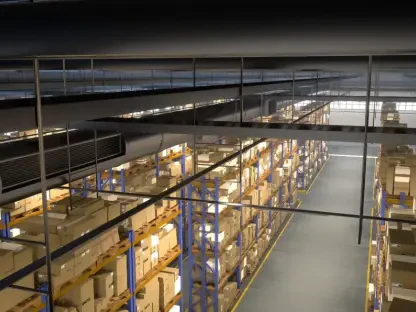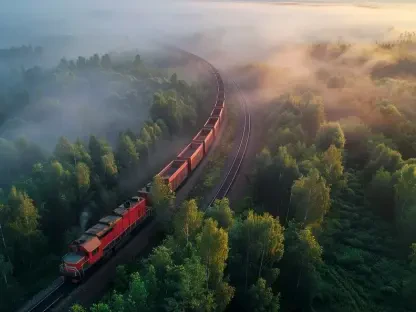What if the arteries of America’s economy and history pulsed through every small town and sprawling city on steel rails? BNSF Railway and Union Pacific, two titans of the U.S. rail industry, move more than just freight—they forge connections, rebuild networks, and honor legacies etched into the landscape. Their latest endeavors reveal a striking balance between modern infrastructure projects and preserving a heritage that has shaped communities for generations. This feature explores how these giants are driving progress while keeping history alive.
The Vital Pulse of Railroads in Modern America
Railroads remain a cornerstone of national commerce, transporting goods worth billions annually across vast distances. BNSF and Union Pacific, as leading Class I railroads, handle a significant share of this load, ensuring that everything from agricultural products to consumer goods reaches markets efficiently. Their role extends beyond logistics, acting as economic engines that support jobs and sustain supply chains in an era of global trade pressures and environmental concerns.
The importance of their work cannot be overstated, especially as sustainability becomes a pressing issue. Rail transport emits far less carbon per ton-mile compared to trucking, positioning these companies as key players in reducing greenhouse gas emissions. Their ongoing investments in infrastructure and community ties demonstrate a commitment to both economic vitality and cultural preservation, making their story one of national significance for businesses, policymakers, and history enthusiasts alike.
BNSF’s Drive for Connectivity and Growth
In Sunray, Texas, BNSF has completed a transformative $8.2 million project with TXNW Railway, a short line partner, to rebuild and extend interchange tracks. This initiative, funded equally by TXNW and a federal grant from the Consolidated Rail Infrastructure and Safety Improvements (CRISI) program, enhances efficiency and market access for smaller railroads. The upgraded tracks allow seamless integration into BNSF’s expansive network, a milestone marked by a public ribbon-cutting event that showcased the power of collaboration.
This project falls under BNSF’s Shortline Select program, which fosters partnerships with short lines like Genesee & Wyoming’s operations to blend localized service with broad reach. Such efforts highlight a growing trend in the industry where large-scale railroads work hand-in-hand with smaller entities to address regional needs. The result is a stronger, more interconnected rail system that benefits rural economies and global trade routes alike.
Union Pacific’s Tribute to Rail History
On a different note, Union Pacific has turned its attention to celebrating the past by naming Tehachapi, California, its 134th “Train Town USA.” Located near Sequoia National Forest, this town is home to the iconic Tehachapi Loop, a 0.73-mile engineering wonder where trains pass over themselves on a steady 2% grade. Recognized as a Historic Civil Engineering Landmark, the loop stands as a testament to rail innovation and is set to celebrate its 150th anniversary next year.
The designation, announced during a ribbon-cutting at the Historic Tehachapi Railroad Depot and Museum, underscores the cultural weight of rail towns. Union Pacific’s initiative aims to foster community pride and historical awareness, drawing attention to sites that have shaped America’s rail narrative. Local residents and visitors alike continue to marvel at the loop’s visual spectacle, a living reminder of engineering feats that still captivate after more than a century.
Voices Echoing from the Rails
BNSF General Director of Marketing Mark Ganaway, speaking at the Sunray project event, emphasized the value of collaboration, stating that programs like Shortline Select “build pathways for growth for both short lines and their customers.” His words reflect a strategic vision that prioritizes shared success over isolated gains. The sentiment from local stakeholders in Texas echoed this, with many noting how improved rail access opens new opportunities for businesses in the region.
Meanwhile, in Tehachapi, Union Pacific Senior Director of Public Affairs Peggy Ygbuhay called the town “a vital thread in the fabric of America’s rail history.” Her remarks during the Train Town USA ceremony highlighted the enduring bond between railroads and the communities they serve. Attendees shared stories of watching trains navigate the loop, their awe underscoring how such landmarks evoke a deep emotional connection to the nation’s industrial past.
Lessons in Balancing Innovation and Tradition
The approaches of BNSF and Union Pacific offer valuable insights for communities and businesses aiming to engage with rail initiatives. One key takeaway is the power of partnerships, as seen in BNSF’s model of leveraging federal grants like CRISI to fund infrastructure upgrades. Smaller entities can adopt this strategy by identifying local needs and aligning with larger programs that distribute costs and amplify impact.
Another lesson comes from Union Pacific’s focus on heritage, suggesting that recognizing historical significance can strengthen community identity. Towns with rail ties might consider organizing events or seeking designations to highlight their unique stories, drawing tourism and fostering civic pride. Both companies also demonstrate the importance of public engagement, hosting events like ribbon-cuttings to build trust and ensure their projects resonate with those directly affected.
Looking back, the efforts of BNSF and Union Pacific stand as powerful examples of how industry leaders can navigate the dual demands of progress and preservation. Their projects in Texas and California illustrate a shared commitment to enhancing connectivity while honoring the past. Moving forward, stakeholders across the rail sector might consider how to replicate these strategies—whether through collaborative funding for infrastructure or initiatives that celebrate history—to ensure that railroads continue to serve as vital links in both economic and cultural landscapes.









